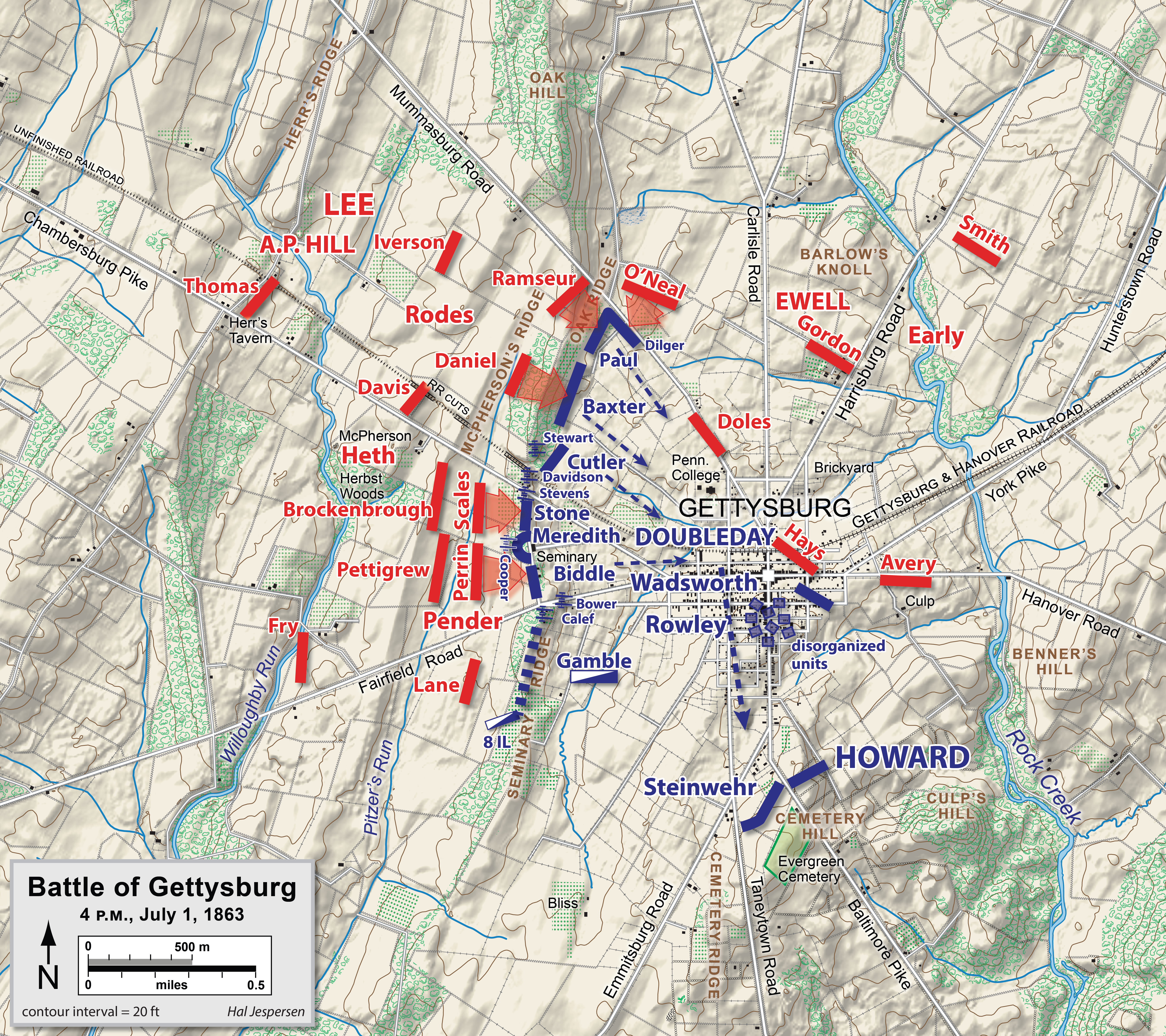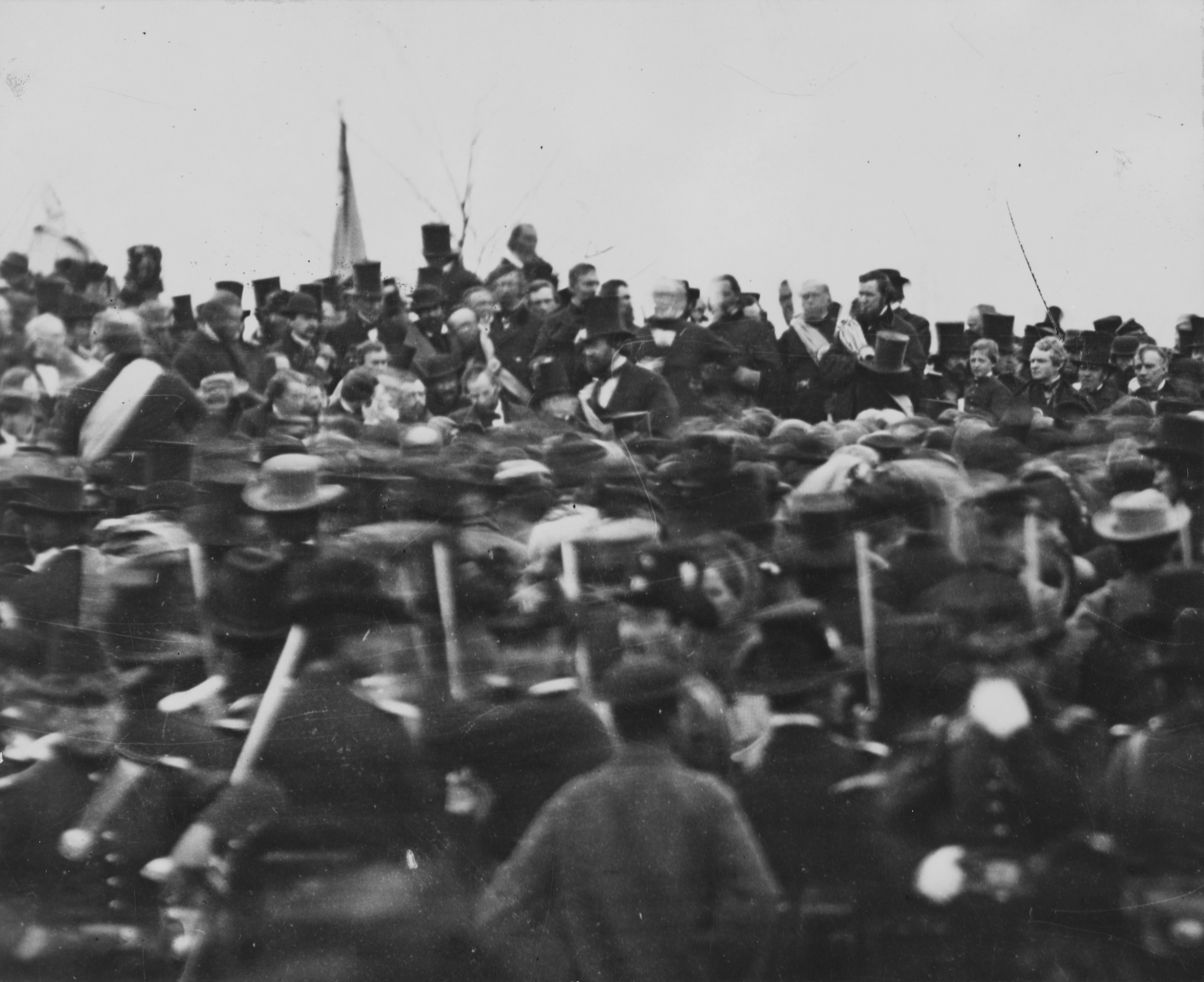|
Seminary Ridge
Seminary Ridge is a dendritic ridge which was an area of Battle of Gettysburg engagements in July 1863 during the American Civil War (1861–1865), and of military installations during World War II (1941–1945). Geography Seminary Ridge is a northern portion of the drainage divide between the Marsh Creek Watershed on the west and the Rock Creek Watershed (east). At the south end of Oak Ridge (the northernmost portion of the divide), the north-south McPherson and Seminary ridges bifurcate southward at the triple watershed point of Willoughby's and Pitzer runs (southward tributaries of Marsh Creek) with a Rock Creek eastward tributary. From the triple point, Seminary Ridge extends southward to an area with eastward drainage into the Rock Cr tributary ( Stevens Creek), with the borough of Gettysburg, and with the TBD. Farther south into the Gettysburg National Park, Seminary Ridge continues as far as a branch of Pitzer Run, which divides the ridgeline (), around which th ... [...More Info...] [...Related Items...] OR: [Wikipedia] [Google] [Baidu] |
Lutheran Theological Seminary At Gettysburg
The Lutheran Theological Seminary at Gettysburg (Gettysburg Seminary) was a seminary of the Evangelical Lutheran Church in America (ELCA) in Gettysburg, Pennsylvania. It was one of seven ELCA seminaries, one of the three seminaries in the Eastern Cluster of Lutheran Seminaries, and a member institution of the Washington Theological Consortium. It was founded in 1826 under prominent but controversial theologian and professor Samuel Simon Schmucker (1799-1873) for the recently organized General Synod of the Evangelical Lutheran Church in the United States. The seminary was the oldest continuing Lutheran seminary in the United States until it was merged on July 1, 2017, after 189 years of operation, with the nearby and former rival Lutheran Theological Seminary at Philadelphia to form the United Lutheran Seminary. The new institution continues to use both campuses. The Gettysburg Seminary served the church as a pioneer in theological education creating among Lutheran seminaries th ... [...More Info...] [...Related Items...] OR: [Wikipedia] [Google] [Baidu] |
Rock Creek (Monocacy River)
Rock Creek is an tributary of the Monocacy River in south-central Pennsylvania and serves as the border between Cumberland and Mount Joy townships. Rock Creek was used by the Underground Railroad (at McAllister's Mill, "slaves would slosh through the water to throw off the tracking dogs that were pursuing them") and flows near several Gettysburg Battlefield sites, including Culp's Hill, the Benner Hill artillery location, and Barlow Knoll. , align=left , , - , , Harrisburg Road site of forme1846 covered bridgebuilt by Joseph Clapsaddle near Barlow Knoll , align=center, , - , Run , drainage from the east , align= , - , Run , Drainage along former site of Alm's house from Gettysburg College's Quarry Lake & Oak Ridge triple point (with Willoughby/Pitzer Runs) , align=left, , - , Stevens Creek , , align=left, , - , Island , Depicted on 1916 Gettysburg National Military Park map , , - , Run , (Depicted on battlefield map at right) , , - , Railroad ... [...More Info...] [...Related Items...] OR: [Wikipedia] [Google] [Baidu] |
Frederick William Sievers
Frederick William Sievers (October 26, 1872 – 1966) was an American sculptor, born in Fort Wayne, Indiana. Sievers moved to Richmond, Virginia, as a young man, furthering his art studies by attending the Royal Academy of Fine Arts in Rome, where he studied under Ettore Ferrari and the Académie Julian in Paris. In 1910 when Sievers was commissioned to create the Virginia Monument at Gettysburg, Pennsylvania, he opened a studio in Richmond. Following the success of the Virginia Monument at Gettysburg, Sievers sculpted a number of other statues commemorating the American Civil War, including the Confederate Monument in Woodlawn Cemetery, Elmira, New York, and others in Abingdon, Leesburg, Louisa, and Pulaski County, Virginia. He further produced monuments to specific Confederate leaders, General Tilghman at Vicksburg, Mississippi and General Stonewall Jackson and Matthew Fontaine Maury, both on Monument Avenue in Richmond.Opitz, Glenn B, Editor, Mantle Fielding's Dictio ... [...More Info...] [...Related Items...] OR: [Wikipedia] [Google] [Baidu] |
Eisenhower National Historic Site
Eisenhower National Historic Site preserves the home and farm of Dwight D. Eisenhower, the 34th President of the United States, and its surrounding property of . It is located in Cumberland Township, Adams County, Pennsylvania, just outside Gettysburg. Purchased by then-General Eisenhower and his wife Mamie in 1950, the farm served as a weekend retreat for the President and a meeting place for world leaders, and became the Eisenhowers' home after they left the White House in 1961. With its putting green, skeet range, and view of South Mountain and the Gettysburg Battlefield, it offered President Eisenhower a much-needed respite from the pressures of Washington. It was also a successful cattle operation, with a show herd of black Angus cattle. Some of the more notable of Eisenhower's guests were Premier Nikita Khrushchev of the Soviet Union, President Charles de Gaulle of France, Prime Minister Winston Churchill of Britain, and Governor Ronald Reagan of California (who lat ... [...More Info...] [...Related Items...] OR: [Wikipedia] [Google] [Baidu] |
National Register Of Historic Places Listings In Adams County, Pennsylvania
__NOTOC__ This is a list of the National Register of Historic Places listings in Adams County, Pennsylvania. This is intended to be a complete list of the properties and districts on the National Register of Historic Places in Adams County, Pennsylvania, United States. The locations of National Register properties and districts for which the latitude and longitude coordinates are included below, may be seen in a map. There are 35 properties and districts listed on the National Register in the county. One site is further designated as a National Historic Site and another is designated as a National Military Park. Another property was once listed but has been removed. Current listings Former listings See also * List of Pennsylvania state historical markers in Adams County __NOTOC__ Pennsylvania state historical markers in Adams County by the Pennsylvania Historical and Museum Commission (PHMC) are 44 signs, including 1 ... [...More Info...] [...Related Items...] OR: [Wikipedia] [Google] [Baidu] |
Gettysburg, Pennsylvania
Gettysburg (; non-locally ) is a borough and the county seat of Adams County in the U.S. state of Pennsylvania. The Battle of Gettysburg (1863) and President Abraham Lincoln's Gettysburg Address are named for this town. Gettysburg is home to the Gettysburg National Military Park, where the Battle of Gettysburg was largely fought; the Battle of Gettysburg had the most casualties of any Civil War battle but was also considered the turning point in the war, leading to the Union's ultimate victory. As of the 2020 census, the borough had a population of 7,106 people. History Early history In 1761, Irishman Samuel Gettys settled at the Shippensburg-Baltimore and Philadelphia-Pittsburgh crossroads, in what was then western York County, and established a tavern frequented by soldiers and traders. In 1786, the borough boundary was established, with the Dobbin House tavern (established in 1776) sitting in the southwest. As early as 1790, a movement seeking to split off the western ... [...More Info...] [...Related Items...] OR: [Wikipedia] [Google] [Baidu] |
Monocacy River
The Monocacy River () is a free-flowing left tributary to the Potomac River, which empties into the Atlantic Ocean via the Chesapeake Bay. The river is long,U.S. Geological Survey. National Hydrography Dataset high-resolution flowline dataThe National Map , accessed August 15, 2011 with a drainage area of about . It is the largest Maryland tributary to the Potomac. The name "Monocacy" comes from the Shawnee name for the river ''Monnockkesey'', which translates to "river with many bends." (However, another local tradition asserts that "Monocacy" means "well-fenced garden" in an Indian language.) The first town ever settled in Western Maryland, Monocacy, also gets its name from this river. The Monocacy National Battlefield lies alongside part of the river, marking an 1864 engagement during the American Civil War, the Battle of Monocacy Junction. The Chesapeake and Ohio Canal crosses over the river at the Monocacy Aqueduct, the largest of the 11 aqueducts on the canal. ... [...More Info...] [...Related Items...] OR: [Wikipedia] [Google] [Baidu] |
Mason–Dixon Line
The Mason–Dixon line, also called the Mason and Dixon line or Mason's and Dixon's line, is a demarcation line separating four U.S. states, forming part of the borders of Pennsylvania, Maryland, Delaware, and West Virginia (part of Virginia until 1863). It was surveyed between 1763 and 1767 by Charles Mason and Jeremiah Dixon as part of the resolution of a border dispute involving Maryland, Pennsylvania, and Delaware in colonial America. The dispute had its origins almost a century earlier in the somewhat confusing proprietary grants by King Charles I to Lord Baltimore (Maryland) and by King Charles II to William Penn (Pennsylvania and Delaware). The largest, east-west portion of the Mason–Dixon line along the southern Pennsylvania border later became known, informally, as the boundary between the Southern slave states and Northern free states. This usage came to prominence during the debate around the Missouri Compromise of 1820, when drawing boundaries betwee ... [...More Info...] [...Related Items...] OR: [Wikipedia] [Google] [Baidu] |
Gettysburg Battlefield
The Gettysburg Battlefield is the area of the July 1–3, 1863, military engagements of the Battle of Gettysburg within and around the borough of Gettysburg, Pennsylvania. Locations of military engagements extend from the site of the first shot & at Knoxlyn Ridge on the west of the borough, to East Cavalry Field on the east. A military engagement prior to the battle was conducted at the Gettysburg Railroad trestle over Rock Creek, which was burned on June 27. Geography Within of the Maryland/Pennsylvania state line, the Gettysburg battlefield is situated in the Gettysburg-Newark Basin of the Pennsylvania Piedmont entirely within the Potomac River Watershed near the Marsh and Rock creeks' triple point with the Susquehanna River Watershed (near Oak Hill) occupying an area . Military engagements occurred within and around the borough of Gettysburg (1863 pop. 2,400), which remains the population center for the battlefield area at the intersections of roads that connect th ... [...More Info...] [...Related Items...] OR: [Wikipedia] [Google] [Baidu] |
Warfield Ridge
The Gettysburg Battlefield is the area of the July 1–3, 1863, military engagements of the Battle of Gettysburg within and around the borough of Gettysburg, Pennsylvania. Locations of military engagements extend from the site of the first shot & at Knoxlyn Ridge on the west of the borough, to East Cavalry Field on the east. A military engagement prior to the battle was conducted at the Gettysburg Railroad trestle over Rock Creek, which was burned on June 27. Geography Within of the Maryland/Pennsylvania state line, the Gettysburg battlefield is situated in the Gettysburg-Newark Basin of the Pennsylvania Piedmont entirely within the Potomac River Watershed near the Marsh and Rock creeks' triple point with the Susquehanna River Watershed (near Oak Hill) occupying an area . Military engagements occurred within and around the borough of Gettysburg (1863 pop. 2,400), which remains the population center for the battlefield area at the intersections of roads that connect the ... [...More Info...] [...Related Items...] OR: [Wikipedia] [Google] [Baidu] |




